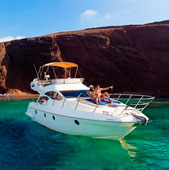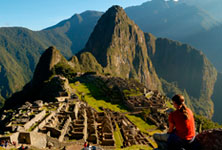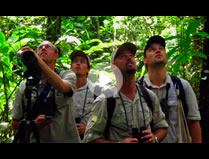Archaeological sites around Cuzco
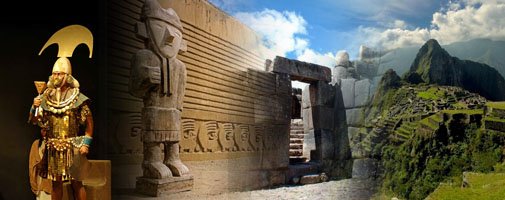
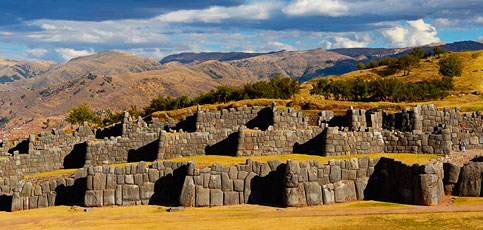 This is an Inca architectural masterpiece showing impressive megalithic ruins that are located on the peak of a hill and which dominates the north of the city. The historians of the Spanish conquest gave it military purpose which later became a religious sanctuary and finally a place of work.
This is an Inca architectural masterpiece showing impressive megalithic ruins that are located on the peak of a hill and which dominates the north of the city. The historians of the Spanish conquest gave it military purpose which later became a religious sanctuary and finally a place of work.
The walls of this site are formed by enormous stone blocks that reach up to 9m height,5m width and 4m. thickness. The largest is calculated to weigh over 125 tons. The union of these enormous rocks, assembled in a perfect union without the use of cement is incredible. The main wall consists of three successive walls in zigzag, with the second and the third superimposed on the first.
The platforms have an average length of 360m and communicate by stairs, and access doors. The throne of the Inca is surrounded by rocks in front of the ramparts that dominate the esplanade and the "rodadero" (circular place) is located in the same plateau.
Every year the evocation to the Inti Raymi is celebrated here and is located only 3 km from the Main Square of Cuzco.
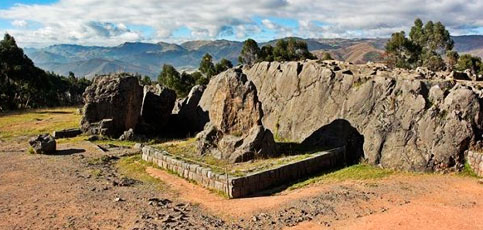 This is asanctuary dedicated to the adoration of animals, and consists of ruins formed by a rocky site with stairs in zigzag, and a main building similar to a circular amphitheatre where 19 window sills are located as a way of seats.
This is asanctuary dedicated to the adoration of animals, and consists of ruins formed by a rocky site with stairs in zigzag, and a main building similar to a circular amphitheatre where 19 window sills are located as a way of seats.
It is presumed that this place was a site of adoration, and supporting this presumption is the presence of an enormous stone block of 5.9m height that resembles the appearance of a puma. There is a labyrinthine entrance towards several underground galleries, passages, channels and stairs with signs of an earlier culture. These reveal themselves in a series of drawings and engravings including outstanding figures of pumas.
It is located 4 km from the Main Square following the way to Sacsayhuaman.
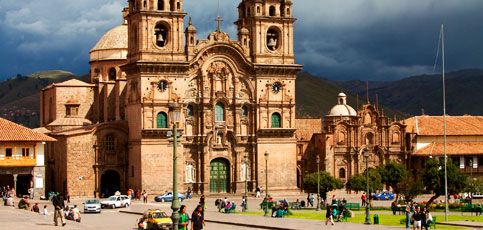 This is an Inca archaeological site located again on the peak of a hill and is thought to be a military position and an administrative centre.
This is an Inca archaeological site located again on the peak of a hill and is thought to be a military position and an administrative centre.
Due to its proximity to Tambomachay, it is believed to have had a relationship with its defense, as well as the control of the route to Calca that led to the Antisuyo (Forest county of the Inca).
It is a fortification formed by platforms, stairs, passages, turrets, windowsills and a wall that defends the whole construction in one circular shape.
It is located 7 km from the Main Square.
 This was an Inca sanctuary dedicated to the cult of the water, and it was a reserved place for the Inca. It is known as the "Baños del Inca" (Inca's spa). Its construction of fine lithic finish is a startling example of incredible hydraulic engineering.
This was an Inca sanctuary dedicated to the cult of the water, and it was a reserved place for the Inca. It is known as the "Baños del Inca" (Inca's spa). Its construction of fine lithic finish is a startling example of incredible hydraulic engineering.
Consisting of a group of walls that are united by stairs, there are springs that cascade to a pool through several channels. The waterfalls in these ruins form part of a terrace to the second wall where the drainage cascades on the first and forms a small pool.
The window sills, hole or niches are of 2m height, and was the place, according to the historians, that the Inca and the important people of his court offered water rites to the god Inti (sun).
It is located 8 km from the Main Square.
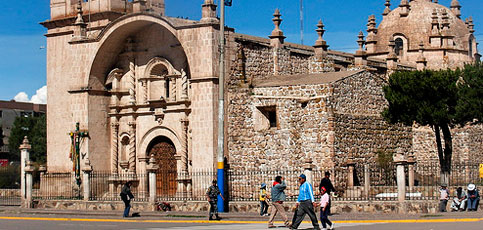 Thesepre-Hispanic adoration sites are located 5 km east of Cusco with representations of feline, monkey and snake images that have been carved into the rocks. This is a particularly interesting place for the followers of occult and spiritual movements.
Thesepre-Hispanic adoration sites are located 5 km east of Cusco with representations of feline, monkey and snake images that have been carved into the rocks. This is a particularly interesting place for the followers of occult and spiritual movements.
On the highway that joins Cusco with the northwestern part of "Valle Sagrado de los Incas" (SacredValley of the Incas), with a beautiful view of the Mountain Range of Urubamba, with beautiful snowy peaks, and some lagoons, we can visit:
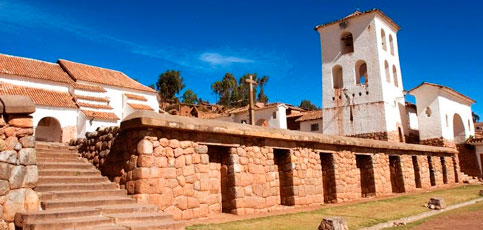 Located some 28 km (17.4 miles) to the northwest of Cusco, the so-called "El Pueblo Del Arco Iris" (the town of the rainbow), or Chinchero is an ancient town of Hispanic architecture but built on old Inca construction.
Located some 28 km (17.4 miles) to the northwest of Cusco, the so-called "El Pueblo Del Arco Iris" (the town of the rainbow), or Chinchero is an ancient town of Hispanic architecture but built on old Inca construction.
Its people are the most conservative of the Inca traditions, wearing traditonal clothing and are famous for carrying out the "catu", or exchange fair of agricultural products, in which the use of the currency is discarded and everything is made in exchange. Also outstanding are their textile crafts. The town also has a beautiful colonial church with famous paintings of the Escuela Cusqueña (Cuzco school) depicting beautiful Andean landscapes surround the town, along with the snowy mountains of Chicon and Veronica in the Urubamba mountain range.
 Located some 53 km northwest of Cusco, Moray exhibits an admirable Inca experimental farm, where a natural depression has been transformed into enormous terraces superimposed in concentric form in the shape of a coliseum Achieving up to 150 metres in height levels, this technology allowed the old Inca farmers to study the effects of altitude on different plants and create diverse microclimates to experience and to obtain a variety of plants.
Located some 53 km northwest of Cusco, Moray exhibits an admirable Inca experimental farm, where a natural depression has been transformed into enormous terraces superimposed in concentric form in the shape of a coliseum Achieving up to 150 metres in height levels, this technology allowed the old Inca farmers to study the effects of altitude on different plants and create diverse microclimates to experience and to obtain a variety of plants.
It is in fact an ancient agricultural laboratory. Each terrace possesses contention walls which are connected by a complex system of artificial channels of irrigation that again are a sample of incredible Inca technology.
 Located some 60 km (37 miles) from Cuzco and 7km (4.3 miles) from Moray, these salt pans are still used today to crystallize salt from water. These mines were exploited in pre-hispanic times and reach abck to the pre-Inca period. The spectacular scenario of the salt pans forming from an underground river source is a bizarre contrast with the fabulous Andean landscape.
Located some 60 km (37 miles) from Cuzco and 7km (4.3 miles) from Moray, these salt pans are still used today to crystallize salt from water. These mines were exploited in pre-hispanic times and reach abck to the pre-Inca period. The spectacular scenario of the salt pans forming from an underground river source is a bizarre contrast with the fabulous Andean landscape.
 A smalltown located only 5 km(3 miles) southeast of Cusco with its own Main Square and beautiful colonial church, with a facade of carved stone that is richly ornamented.
A smalltown located only 5 km(3 miles) southeast of Cusco with its own Main Square and beautiful colonial church, with a facade of carved stone that is richly ornamented.
Of Baroque style, the church houses a beautiful collection of paintings of Saint John the Baptist's life. Their two towers are identical, in spite of the fact that they were built 155 years apart. Close to this church is located the "Capilla de San Lázaro" (the chapel of San Lázaro), where numerous Spaniards were buried in the "Guerra de Las Salinas" (War of Las Salinas), in a battle that was sustained between the Spanish conquerors Hernando Pizarro and Diego de Almagro for the domain of Cusco in 1538.
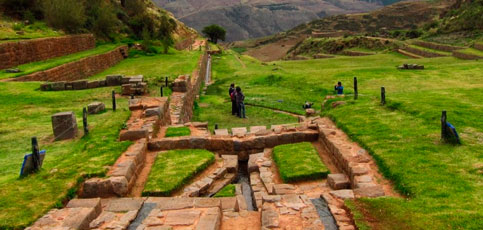 Another significant Inca archaeological site located 23 km (14 miles) southeast of Cusco. Predominantly it is an agricultural area with megalithic buildings and a beautiful citadel. There is also a great "andenería" (terrace) group, with terraces of great size that diminish in size as it ascends to the landscape of the mountain. A great wall covers all the contours of this area; at the center of which is a group of buildings built with immense rocks and where there are the remains of an old citadel. A great Inca population is thought to have once existed here.
Another significant Inca archaeological site located 23 km (14 miles) southeast of Cusco. Predominantly it is an agricultural area with megalithic buildings and a beautiful citadel. There is also a great "andenería" (terrace) group, with terraces of great size that diminish in size as it ascends to the landscape of the mountain. A great wall covers all the contours of this area; at the center of which is a group of buildings built with immense rocks and where there are the remains of an old citadel. A great Inca population is thought to have once existed here.
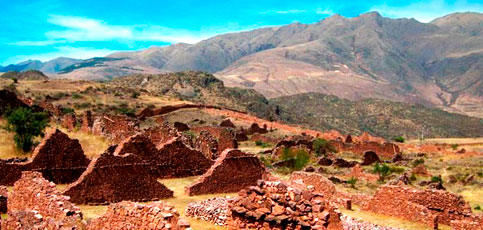 AnInca archaeological site located 38 km (23.6 miles) southeast of Cusco, and is the remains of a city that once occupied an area of 50 hectares.
AnInca archaeological site located 38 km (23.6 miles) southeast of Cusco, and is the remains of a city that once occupied an area of 50 hectares.
There are large buildings present, some of two floors, embankments, great walls that reach up to 7m in height and aqueducts. Other highlights include the great quantity of colcas (grain deposits), and the style of their construction, with small stones, joined with mud. This is a site where one can magnify the reach achieved by the Inca in its architecture and urban organization. Some historians believe there was a military purpose to this site as a center of supplies because ofthe large deposits of agricultural products, tools, dresses and weapons that have been found.
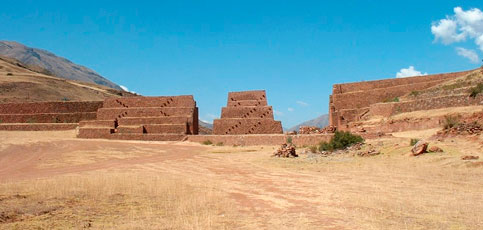 An Inca archaeological site located 39 km (24.2 miles) southeast of Cusco and 1 km (0.62 miles) from Piquillacta. It constituted the main and obligatory entrance to Cusco en route to the Collasuyo (county of the south, in the Tahuantisuyo), and had the functions of a customs post. A great and imposing cover is built in carved stone, and is surrounded by high walls in which through the inferior vertex a water channel flows. There is also a great aqueduct present that was used as the water supply for the population of Piquillacta.
An Inca archaeological site located 39 km (24.2 miles) southeast of Cusco and 1 km (0.62 miles) from Piquillacta. It constituted the main and obligatory entrance to Cusco en route to the Collasuyo (county of the south, in the Tahuantisuyo), and had the functions of a customs post. A great and imposing cover is built in carved stone, and is surrounded by high walls in which through the inferior vertex a water channel flows. There is also a great aqueduct present that was used as the water supply for the population of Piquillacta.
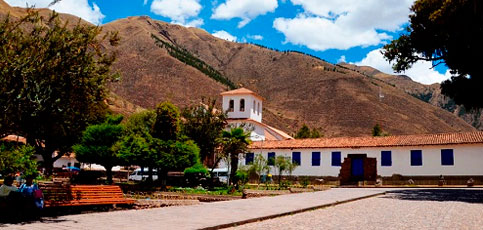 Atown located some 45 km southeast of Cusco, is home to a church that houses one of the most valuable jewels of the colonial art of Peru, the Capilla Sixtina of Peru. The interior of the Church of San Pedro of Andahuaylillas is an explosion of Baroque art with a great quantity of decorative features.
Atown located some 45 km southeast of Cusco, is home to a church that houses one of the most valuable jewels of the colonial art of Peru, the Capilla Sixtina of Peru. The interior of the Church of San Pedro of Andahuaylillas is an explosion of Baroque art with a great quantity of decorative features.
It was built in 1631, and according to the Spanish tradition on the foundations of an Inca temple. It has numerous and very beautiful paintings of the Escuela Cusqueña with altars and wood carvings in gold leaf.
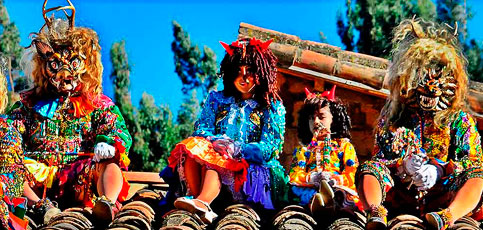 A town of Spanish Colonial and Inca (mestizo) architecture some 4300 meters above sea level (14,107 feet). It is located northeast of the city of Cusco, set amongst a beautiful landscape and is the entrance door to the forest area of Cusco. With rich Inca archaeological sites on its periphery, the town is also known as the folkloric capital of Cusco, and boasts an abundance of dances of Inca origin that are practised to this very day.
A town of Spanish Colonial and Inca (mestizo) architecture some 4300 meters above sea level (14,107 feet). It is located northeast of the city of Cusco, set amongst a beautiful landscape and is the entrance door to the forest area of Cusco. With rich Inca archaeological sites on its periphery, the town is also known as the folkloric capital of Cusco, and boasts an abundance of dances of Inca origin that are practised to this very day.
 Located some 125Km from Cuzco, Raqchi, (pre-Hispanic name Cacha) shows evidence of a complex town that housed several constructions, including terraces, qolqas (storage units), and ceremonial fountains.
Located some 125Km from Cuzco, Raqchi, (pre-Hispanic name Cacha) shows evidence of a complex town that housed several constructions, including terraces, qolqas (storage units), and ceremonial fountains.
The Wiracocha temple in Raqchi is the most important building inside the complex and is believed to have been built by the Inca Wiracocha in honour to the Superior God "Apu Kon Titi Wiracocha".
The temple of Wiracocha is a great construction and is the tallest Inca building in South America. It is 92 metres long (302 feet) and 25.25 metres wide (83 feet) and was completely covered with straw.
Its central wall was built with refined stone carvings with its base of about 3 metres of adobe brick.

Wellness & Health Travel and Tours
A round Peru and Latin America tours specifically created for those who need to recharge their physical and mental energies. A nurturing and enlivening...
Private Jet Charters in Peru and Latin America (View here)
- Christmas in Galapagos & Ecuador Travel
- 2026-27 Christmas in Galapagos & Peru New Year Tour
- 2026-27 Christmas in Galapagos & New Year's in Brazil
- Christmas in Peru and Machu Picchu 2026/2027 - View all
- Christmas Brazil Amazon Cruise
- Christmas Vacations in Costa Rica
- Christmas and New Year in Ecuador & Galapagos Islands
- Christmas and New Year in Chile
- Christmas Vacations in Argentina
- 2026 Christmas Peru and Galapagos Tour
- 2026 Christmas Peru and New Year's Galapagos Tour
- Mexico Christmas and New Year
- New Year's in Peru 2026/2027
- New Year's in Brazil
- Christmas Brazil Tour: Iguazu Falls, Amazon River Cruise from Manaus
- Christmas and New Year's in Latin America 2026/2027
- Brazil & Peru Christmas Highlights Tour - 15 days
- Christmas in Antarctica
- Christmas in the Sun & Beaches
- Winter Christmas & Ski Holidays
- Christmas Cruises
- New Year Getaways

Incl. Miraflores Park, Monasterio & Sanctuary Lodge Hotels, all trains, all private tours, finest service guaranteed
Adan
USA
11th November 2026
Theresa W.
SINGAPORE
9th November 2026

- Ultra Luxury-Luxury Retreat Collection
- Luxury Travel Peru
- Luxury Travel Argentina
- Luxury Travel Brazil
- Luxury Travel Chile
- Luxury Caribbean Trips
- Luxury Travel Galapagos
- Luxury Travel Ecuador
- Luxury Travel Machu Picchu
- Luxury Travel Patagonia
- Luxury Travel Iguassu Falls
- Luxury Travel Mexico
- Luxury Travel Guyana
- Luxury Travel Costa Rica
- Luxury Travel Antarctica
- Luxury Travel Panama
- Luxury Travel Peru & Brazil
- Luxury Travel Peru & ecuador
- Luxury Travel Peru & Costa Rica
- Luxury Travel Peru & Mexico
- Luxury Travel Cuba

Free Cuzco & Machu Picchu Travel Guide
Cusco Tours & Travel Packages
Trekking Tours around Cusco
Cusco Hotels
Cusco Restaurants
Cusco Churches
Cusco Museums
Cusco Archeological sites
About Cusco History
Cusco Food and Drink
Sacred Valley of the Incas
Watch our Inca Trail - Videos here
Watch our Gourmet Tour - Video here
- Peru tours, travel & vacations
- Galapagos tours & cruises
- Ecuador tours, travel & vacations
- Chile tours, travel & vacations
- Brazil tours, travel & vacations
- Bolivia tours, travel & vacations
- Argentina tours, travel & vacations
- Surinam tours, travel & vacations
- Venezuela tours, travel & vacations
- Mexico tours, travel & vacations
- Honduras tours, travel & vacations
- Costa Rica tours, travel & vacations
- Cuba tours, travel & vacations
- Panama tours, travel & vacations
- Tahiti tours, travel & vacations
- Guyana tours, travel & vacations
- Bora Bora tours, travel & vacations
- Antarctica tours, travel & vacations
- Luxury Caribbean tours, travel & vacations
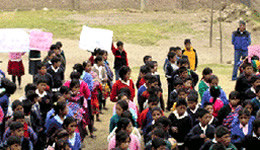
AMAZING PHILANTHROPY
Helping children in one of Peru's poorest village schools supporting hands-on initiatives such as implementation of classrooms to ensuring the robust education, health, and well-being of young children


AMAZING PHILANTHROPY
As part of our philanthropic projects we support the older community to promote sporting and social events in the lesser known regions of Peru.


Honoured to include to distinguished clients by providing jet services and luxury travel in Peru and Latin America
- Robert De Niro Hollywood Actor, Producer & Director
- Zygmunt Solorz-Żak Businessman Forbes Top 100 World's Billionaire
- Diana Raab American Author • Poet • Lecturer Educator and Inspirational Speake
For more information to join our Hiram Bingham Club visit The Hiram Bingham Club © by Amazing Peru:
The Hiram Bingham Club is an exclusive circle of our most passionate & loyal guests - like-minded individuals who want to experience the highest standard in authentic ultra-luxury travel. We have the World’s Most Exclusive Experiences. Venture Beyond the Extraordinary.



